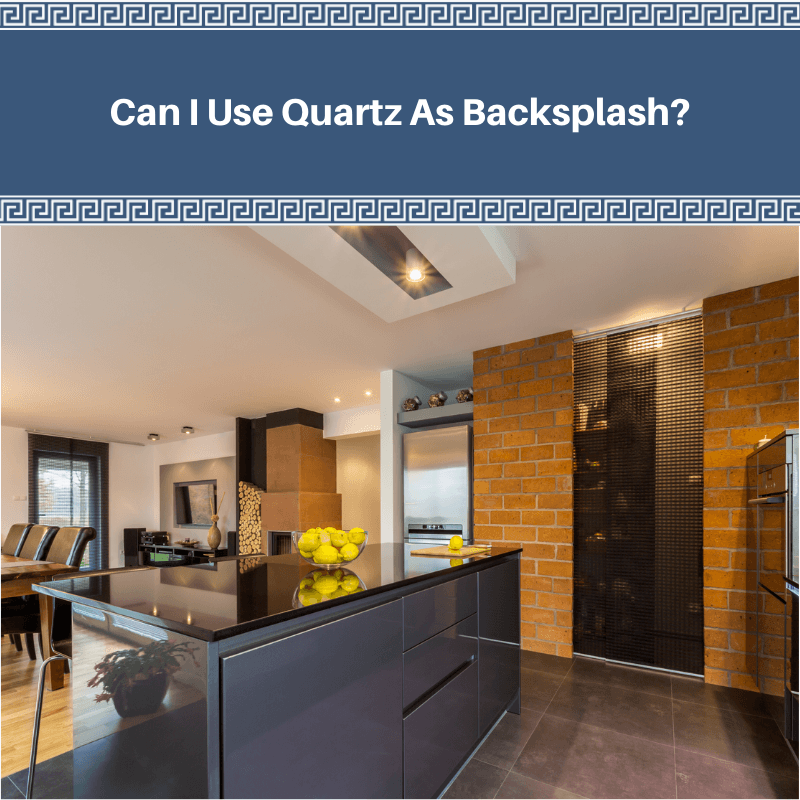Quartz should be on your radar for the kitchen. Brilliantly colored, cheaper than granite, and durable, the popularity of quartz has been skyrocketing recently. You may even be considering quartz for the countertops of your kitchen. But, as you look at your kitchen’s plan, you realize that you still need to decide on a backsplash. Although quartz looks amazing as a counter, will it do you any good as a backsplash?
The short answer: Yes. Now, we are going to tell you why.
What is Quartz?
You probably have a good idea what quartz is if you are here, but let’s not get ahead of ourselves. Knowing a little about quartz can help you decide whether you want a quartz slab backsplash in your kitchen or not.
Quartz countertops are not quartz stone. Not completely. Quartz is engineered from a mixture of quartz stone, resin, and other materials to make a beautiful slab of stone. Some can even look like marble and granite, and if you never told anyone, people would not be able to guess otherwise. These days, you can find quartz countertops in every color under the sun, making kitchen customization easier than ever before.
That includes adding quartz as a backsplash to your kitchen.
Why You Should Install a Backsplash
A backsplash, or a panel that protects the wall from splashes, is basically an extension of the countertop. A backsplash may be a few inches high, or it can extend all the way up to the ceiling, depending on where it is located. From a design standpoint, using quartz for both countertops and your backsplash creates cohesion, adding a sense of fluidity throughout the kitchen.
Obviously, with all the use a kitchen gets, a backsplash is an excellent addition. Not only can you get creative with how it looks, but you also get the assurance knowing that the wall is saved from grease, water, and other things that could make it dirty. A backsplash is going to be made of material that is much easier to clean than, let’s say, a painted section of wall.
Best of all, adding a backsplash is not expensive, especially if you are using the same material that makes up your countertops. In this case, it is quartz countertops with quartz backsplash.
Can Quartz Be Used as a Backsplash?
You probably already figured out that the answer is yes. Quartz can certainly be used as a kitchen backsplash. Beautiful, versatile, and durable, quartz has many properties that fulfill the role of backsplash perfectly. As mentioned earlier, quartz is engineered and nonporous, unlike granite. Therefore, it will repel moisture and bacteria from the walls where the backsplash is placed.
Are There Any Drawbacks?
Now, despite every reason there is to get yourself a quartz backsplash, you need to remember that quartz does have some disadvantages. Unlike other similar materials, quartz is not heat resistant. There is less of an impact on a quartz backsplash than with a countertop, but you should exercise caution when placing a quartz backsplash near an extreme source of heat.
Furthermore, quartz backsplashes do not have the same visual appeal of granite or marble. Because the stone is manufactured, there is very little variance in color, and some patterns may be dull or repetitive.
What are Some Ways to Use Quartz as Backsplash?
Quartz can be a main player in the overall design of your kitchen, or it can be a secondary role—a feature, if you will. A single quartz slab backsplash can be fabricated a number of ways. From an array of colors to the thickness, shape, and installation, quartz is flexible. You can let your creativity flow.
For instance, you can choose similarly colored slabs of quartz to complement one another. Or you can create an eye-catching contrast. For example, you might decide to go with a smokey gray countertop then use a marbled quartz of gray and white to help draw the eye up towards features over a metallic stove top.
Here are some popular quartz types and tips for how to use them as a backsplash:
- Blanca Arabescato Quartz: A timeless look. Blanca Arabescato looks a little like Italian marble with its gray background and brown-gray veins. The veins are long and mottled, creating a luxurious pattern that looks amazing as a countertop and backsplash duo.
- Calacutta Classique Quartz: Looking for something bolder? Check out the large bands of gray that wend through the soft white of this quartz. The smooth swaths of gray do well with minimalist kitchens.
- Calacutta Laza Quartz: The aesthetic appeal of Calacutta Laza is from the cool white and gray veining, which looks elegant among stainless steel features and more contemporary designs. The gray also looks good alongside gray and blue walls, wooden accents, and brushed metal appliances.
- Calacutta Verona Quartz: Colored with a white base and taupe or grayish veining throughout, this quartz compares well to marble in style. The warm taupe looks wonderful with wooden elements.
- Mystic Gray Quartz: Almost solid gray, this type of quartz uses multiple tones of gray to create added dimension. It is a great choice for a backsplash, because it can offset brighter colors in the kitchen or give warmth to otherwise industrial looking features.
Conclusion
Quartz is low maintenance and durable, making it ideal for both countertops and backsplashes. Quartz backsplashes come in a range of colors, so you can find one that suits personal tastes. Add some flair to your kitchen today with quartz!
Marble Concepts can help you choose the best quartz countertops with quartz backsplash for your home. Get in touch with us today by calling 215-396-7393 or sending a message via the contact form.






